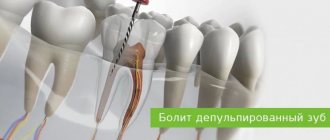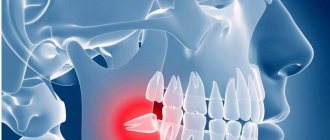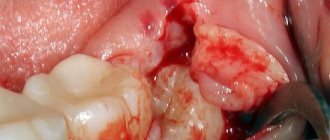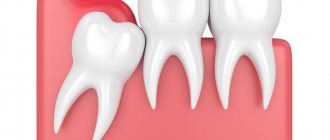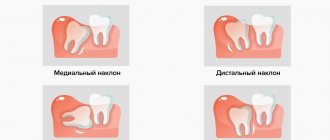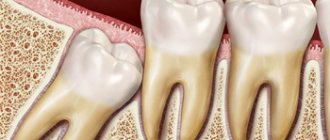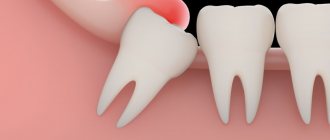A wisdom tooth is the 8th tooth in a row (figure eight) or 3rd molar, its eruption period is 17-25 years. This is a large molar, often with a complex root system. The peculiarities of its development and growth in most cases become the cause of various dental problems. Although the structure of the figure eight is characterized as an ordinary molar, its chewing function is practically absent. If a wisdom tooth hurts, it is rarely preserved. The figure eight is destroyed early, often erupts with a carious lesion, grows at an angle or in a horizontal position.
How can you tell if your wisdom tooth hurts?
Eights erupt much later than all the other teeth in the row, when the dentofacial apparatus is fully formed, and there is simply not enough space for a beginner. Due to the density of the gums and bone tissue, eruption is quite painful, accompanied by inflammation of the gums and damage to neighboring units. Pain during wisdom tooth growth is quite specific:
- Spreads along the jaw, extends to the temple, neck, head, ear, throat;
- around the figure eight there is swelling and redness of the gum tissue;
- due to pain and sore throat, swallowing is difficult;
- numbness of the jaw and severe pain indicate that the 3rd molar is growing crookedly, injuring the jaw nerve;
- it is difficult to open your mouth, especially if the wisdom tooth grows in the opposite direction from the jaw.
Each similar symptom indicates the presence of problems with the 3rd molar. You can temporarily relieve pain when wisdom teeth erupt with an analgesic. If the figure eights grow crookedly, the bite is disturbed, the cheek or gums are injured, they form in the bone tissue without erupting to the surface or appear only partially - they must be removed.
Symptoms of tooth pericoronitis
The main clinical manifestations of dental pericoronitis may be the following symptoms:
- swelling of the soft tissue of the gums in the area of the growing tooth;
- redness of soft tissues;
- pain that worsens when eating and brushing teeth;
- pain radiating to the temple, ear or eye socket (on the affected side);
- Difficulty opening the mouth and talking due to pain and swelling;
- bad breath;
- purulent discharge from under the gingival hood;
- increase in body temperature to 37.5 degrees.
If the disease has acquired a serious form, an increase in the submandibular and parotid lymph nodes (on the affected side) is observed, as well as a significant deterioration in the patient’s well-being.
Meanwhile, the most characteristic manifestations of wisdom tooth pericoronitis are:
- swelling of the gums;
- redness of the gums;
- pain in the gum area.
Often, with acute pericoronitis, the swelling is so severe that the patient has difficulty speaking and it becomes difficult to open and close his mouth.
Why can a wisdom tooth hurt?
- Non-standard eruption
- impacted teeth formed in the jawbone, not erupted completely or partially, can be positioned horizontally or vertically. When the figure eight is placed on the side, it puts strong pressure on neighboring units, causing acute pain. - Gum hood
– dense gums can prevent teething; a “hood” of mucous tissue forms over the wisdom tooth. Bacteria and food particles begin to accumulate under it, which cannot be removed when brushing your teeth. This area is constantly injured, inflamed, and painful. An acute inflammatory process often develops into a purulent one. - The molar is rotated
around its axis - the more pronounced the rotation, the stronger the impact on the dental nerve, which causes pain in the molar itself, the adjacent unit or the entire jaw. - The cheek hurts
due to a wisdom tooth if it grows in its direction. The pain intensifies when chewing, the mucous membrane of the cheek is constantly injured and inflamed. - Caries
- the localization of the 3rd molar makes it difficult to care for it; often it is cut already with carious lesions of hard tissues, which causes pain. The sensitivity of the tooth increases, it reacts painfully to temperature and chemical stimuli. - Cyst
- due to systematic injury to the gum tissue, the molar itself, a cystic formation may form at the neck. A wisdom tooth cyst is often accompanied by serious complications - inflammation of the periodontal tissues, pericoronitis, abscess, and destruction of bone tissue.
Also, the reason that the wisdom tooth began to hurt are various dental pathologies - pulpitis, periodontitis (acute, chronic), periodontal disease. Removing the figure eight is not always justified; the doctor decides this issue individually, depending on the clinical picture. First, a comprehensive diagnosis is carried out, the doctor determines the location of the roots, assesses the condition of the jaw bone, gums around the figure eight, and the entire dentofacial apparatus.
Experts' opinion
Numerous clinical studies have proven the therapeutic effect of many products in the Asepta line.
When using the drugs, all patients in the focus group noticed a pronounced analgesic effect. After using the rinses, tissue healing was observed in all patients, and the hygienic condition of the oral cavity improved. The products are recommended for the complex treatment of patients, and their availability and simplicity make it possible to recommend them for the clinical practice of dentists. In addition, according to the results of clinical studies, after 3 weeks of using ASEPTA® rinse, gum bleeding is reduced by 28.3%, inflammation is reduced by 32.3% and the hygienic condition of the oral cavity is improved by 33.5%*.
Indications for removal
- Pathological eruption of the figure eight (partial or complete retention, dystopia), accompanied by pain, chronic inflammation of the gums, destruction of adjacent molars, malocclusion, damage to the jaw joint and other problems;
- 3 molar has erupted outside the dentition, leading to crowding;
- inability to carry out treatment or prosthetics due to limited access to the dental unit;
- the presence of complications - cysts, granulomas, periostitis, periodontitis;
- orthodontic treatment - figure eights must be removed if they interfere with the installation of a corrective apparatus or prevent the teeth from taking the correct position when correcting the bite.
Consumer Reviews
WalkingEmotion about Asepta Active mouth rinse (irecommend.ru):
“Hello everyone) I have been seeing and treating my teeth with the same doctors in a private clinic for 10 years now. And I am very familiar with the Asepta brand, since it is the brand that has a therapeutic and prophylactic effect and is popular in the field of use for gum inflammation. The products are not the cheapest, but they are effective.
In addition to the paste, rinse and balm, I also take vitamins from this brand. But that's not all. Since my gums were inflamed, I was given an appointment with a periodontist, where I received Traumeel injections every day.
I like the packaging design of this brand. Although, of course, the main thing is the result, and not the beautiful shell...
...The tube is made of durable, aqua-colored plastic. But the substance itself has a colorless tint. The kit includes a measuring cup. For one rinse, 10 ml is enough.
I was recommended to rinse 10 ml twice a day after brushing my teeth with Asepta toothpaste. Duration of admission: 10 days.
You need to rinse for about 20 seconds and then do not eat or drink anything for half an hour. Therefore, it is better to do such procedures after eating.
The taste is minty-menthol, it still remains in the mouth for some time after use. It doesn’t turn me off, but on the contrary, you feel clean and fresh.
The product consumes quickly. There is an effect, although it manifests itself together with the use of other preventive agents. Will I buy it again? Yes. Thank you all for your attention to the review!)
lyudikt (otzovik.com):
“Good day, friends and readers of the review site! I want to write about one miracle mouth rinse - ASEPTA Activ. If you come across one, be sure to try this mouthwash. I highly recommend it. Firstly, it not only rinses the oral cavity itself, but also treats the gums, and therefore freshens breath. The effect is very, very good.
When I put this mouthwash into my mouth for the first time, it seemed to me that my mouth was just being “cleaned”. You need to rinse for twenty to thirty seconds; the first time, use just a little to maintain the required time. If you take too much, you simply won’t hold it for the right amount of time and will only “translate the product” and not feel the effect, but if you keep it for the right amount of time, then after rinsing you will feel freshness in your mouth for a long time.
According to the manufacturer itself, this is a remedy for accelerating the relief of signs of mouth inflammation, which contains benzydamine (pain reliever) and chlorhexedine (a broad-spectrum antiseptic).
As the manufacturer himself writes, it is not recommended to use it constantly; it should be used in courses of five to seven days, 2 to 3 times a day.
After use, you feel freshness and the feeling that there is not a single bacteria or parasite in your mouth.
I recommend trying this mouthwash for those who have problems with the oral cavity, it seems to eliminate them and smells so pleasant in the mouth.
The only drawback of this rinse is that it is only 150 ml in a bottle, but if you consider that you only need to use it for 5-7 days and then take a break, then it becomes clear that this is not a drawback, but on the contrary.”
When do you need a doctor's help?
If the figure eight hurts, you should immediately consult a dentist. Consultation with a specialist is also necessary for pain of unknown etiology - squeezing, spreading over the entire jaw, occurring when chewing or opening the mouth. After examination and diagnosis, the doctor will decide what to do next with the molar. If the growth of a wisdom tooth is accompanied by swelling, redness of the gums, and acute pain, the doctor will prescribe anti-inflammatory therapy.
If eruption is difficult due to the gingival hood, an operation will be performed to excise it and drug therapy will be prescribed.
How to eliminate pain and discomfort
In the absence of pathologies, it is possible to eliminate pain by taking painkillers Nurofen and Ibuprofen. Ideally, consult your dentist before using anesthetics.
It is impossible to accelerate growth or influence the process, but you can facilitate it by cutting the gum. The decision about surgery is made by the dentist based on the clinical picture.
Minor inflammations can be easily removed by rinsing the mouth with antiseptic compounds and herbal decoctions. Otherwise, all you have to do is wait for the tooth to erupt. A consultation with a specialist will allow you to identify deviations in time and prevent risks.
Wisdom teeth removal methods
The intervention tactics depend on the location of the 3rd molar, the degree of exposure to the gum surface, the number of roots, their confusion, and the position of adjacent teeth. Removing figure eights on the upper jaw is easier than on the lower jaw. This is due to the structure of the jaw tissue - the maxillary bone is looser, more airy, the mandibular bone is more massive and dense. Additionally, mandibular eights tend to have more tangled and developed roots.
According to the clinical picture, removal can be simple or complex. A simple extraction is performed like any other extraction - the molar is rocked with forceps and removed from the socket. Complex technology includes:
- gum incision;
- drilling a molar or sawing it into fragments;
- removing each fragment one by one;
- suturing the wound.
Stitches are removed on days 5-7
after the intervention (self-absorbable suture material can be used). The operation is performed under local anesthesia; removal under sedation (during medicinal sleep) is possible.
Treatment of wisdom teeth during pregnancy has its own nuances. Usually, the doctor limits himself to conservative therapy aimed at eliminating pain and inflammation. If possible, removal is performed after childbirth. The operation is carried out according to strict indications, if the inflammation has become purulent and threatens the health of the mother and child. For anesthesia, special drugs are used that are safe for the fetus.
At the RUTT clinic, the removal of a wisdom tooth with a complex root system and location is performed by experienced maxillofacial surgeons. This eliminates surgical complications - extensive trauma to the bone structures of the jaw, perforations, wandering root remains, postoperative fistulas, osteomyelitis, etc. Only maxillofacial surgeons have enough skills and experience to perform such interventions without complications.
In what cases is it better to remove a tooth?
Old school dentists insist that at the first discomfort of the patient, wisdom teeth should be removed without regret. Modern dentistry is more humane and is convinced of the need for strict indications for the procedure, rightly noting that in due time “eights” may become the only possible support for dentures.
Indications for removal are:
- eruption of the third molar outside the dentition;
- threat of displacement of adjacent teeth;
- abnormal position of the crown and pressure on the second molar;
- impossibility of therapeutic treatment of the tooth.
Today, at the first visit with complaints of pain caused by the “eight”, the dentist first takes an x-ray to examine the position of the roots, the shape of the tooth and its condition. And only then evaluates all the risks. With this approach, a wait-and-see tactic is increasingly being chosen: the doctor selects painkillers that will help survive the pain that is natural to the teething process. If necessary, incises the gum and cuts off the hood. And then for several months he observes how the wisdom tooth will behave.
Dentists of the Israeli school even fight for impacted wisdom teeth, pulling them out and putting them in the right place with the help of orthodontic instruments. The main thing is that there is enough space in the patient's jaw.
Is it painful to have a wisdom tooth removed?
26% of operations to remove “eights” are no different from the removal of other molars. The wisdom tooth is simply pulled out using hand forceps after local anesthesia is administered. In this case, the patient, as a rule, does not even have time to get scared, the whole procedure goes so quickly.
Another thing is difficult removal. This operation can last up to 40 minutes, during which the surgeon saws the tooth with a drill and takes it out in parts. Unfortunately, this is the only way to remove a tooth that lies horizontally, or has frozen in its development, and has not erupted, but due to its location causes constant pain.
And even in this case, modern anesthesia can completely relieve pain. The same applies to the recovery period. First, in most cases, the surgeon will stitch up the resulting wound, speeding up the healing process. Secondly, he will prescribe painkillers for the coming days. Therefore, you should not be afraid of removal - it will cause much less pain than regular exacerbations.
Recovery after surgery
The removal of the figure eight itself is painless, since it is performed under anesthesia. But due to injury to the gums and bone socket, after the anesthetic wears off, the figure eight, or rather the periodontal tissues, hurt for several days. Painful sensations after a simple removal usually go away within 2-3 days, after a complex one they can persist for about a week. On days 2-3, swelling increases, which subsides after 2 days and the pain subsides. After the intervention, the doctor gives recommendations regarding care, nutrition, lifestyle, and prescribes drug therapy - antibiotics, painkillers, anti-inflammatory drugs, antihistamines.
How to relieve pain?
At the first unpleasant sensations from a growing wisdom tooth, frequent rinsing with Chlorhexidine, Miramistin or Eludril solution helps. If you can’t run to the pharmacy, you can prepare a soda-salt solution: dissolve 1 teaspoon of soda and salt in one glass of warm boiled water.
Supporters of traditional methods can use oak bark, sage and chamomile. To do this, you need to take 3-4 tablespoons of the mixture, composed in equal proportions, and pour 500 ml of boiling water. Leave for an hour and strain before using.
Rinses are effective only if the pain is caused by the natural process of tooth eruption. All of the listed drugs, both pharmaceutical and home-made, relieve swelling well and suppress the activity of pathogenic microflora in the oral cavity.
If symptoms of an attached infection have already developed: fever, swelling, severe swelling, surgical intervention will most likely be required: removal of either the hood or the tooth itself. In order to reduce the risk of complications, the doctor will definitely prescribe antibiotics.
Please note: it is strictly forbidden to prescribe antibiotics to yourself!
But painkillers should be taken before visiting the doctor. In this case, the following are effective:
- Broad spectrum analgesics
. Analgin, Ketanov, Paracetamol relieve pain for several hours, usually from 1 to 5. It is also possible that the tablet will not work at all. You can increase the dose, the main thing is to strictly follow the instructions. - Anti-inflammatory drugs.
Nurofen, Ibuprofen, Diclofenac can not only provide a powerful analgesic effect, but also relieve fever and reduce swelling. - Ointments, gels, sprays for topical use
. Holisal, Metrogyl Denta, Kamistad, Angilex “freeze” any sensations in the sore gum for 2-3 hours.
An ordinary piece of ice relieves pain well. It needs to be wrapped in a cloth and applied to the external projection of the diseased tooth on the cheek. Hold for no more than 5-7 minutes. Do not put ice directly on the gum. Its tissues are too delicate and direct contact can lead to necrosis.
The most original folk method of getting rid of toothache when a wisdom tooth comes out: take a plantain leaf, wash it and roll it into a tube. Then you need to insert the sheet into the auricle, but always on the side on which the tooth hurts. Dentists call such methods useless. But this method does not cause any harm. So why not try?!
Treat or remove?
Although the eruption of the extreme molars causes a lot of discomfort, these units have their significance. They can become supporting teeth for prosthetics. After losing adjacent units, figure eights retain the volume of the jawbone. If your wisdom tooth hurts, treatment is selected after diagnostic measures.
The decision to keep or remove the figure eight is made by the dentist after studying the position of the tooth, the degree of tissue destruction, the severity of symptoms, etc. If, after diagnosis, the doctor recommends removing a molar, you must follow the advice. A diseased wisdom tooth not only threatens the health of the jaw (especially the lower one) and the entire row, it is a constant source of infection in the body. Therapeutic treatment is carried out in the absence of carious complications.

